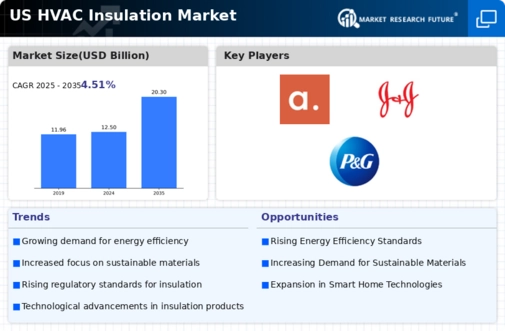Rising Energy Costs
The hvac insulation market is experiencing a notable surge in demand due to the rising energy costs in the US. As energy prices continue to escalate, consumers and businesses alike are increasingly seeking ways to reduce their energy consumption. Insulation plays a critical role in enhancing the energy efficiency of HVAC systems, thereby lowering operational costs. According to recent data, energy costs have risen by approximately 15% over the past year, prompting a shift towards more efficient insulation solutions. This trend is likely to drive growth in the hvac insulation market as stakeholders prioritize investments in insulation technologies that promise long-term savings.
Increased Focus on Indoor Air Quality
The hvac insulation market is significantly influenced by the growing awareness of indoor air quality (IAQ) among consumers and businesses. With a heightened emphasis on health and well-being, there is a rising demand for insulation materials that not only provide thermal efficiency but also contribute to better IAQ. Insulation can help in minimizing the infiltration of pollutants and allergens, thus improving the overall environment within buildings. The market for insulation products that enhance IAQ is projected to grow by 10% annually, indicating a robust opportunity for manufacturers in the hvac insulation market to innovate and cater to this demand.
Government Incentives for Energy Efficiency
The hvac insulation market is positively impacted by various government incentives aimed at promoting energy efficiency. Federal and state programs are increasingly offering tax credits and rebates for energy-efficient upgrades, including insulation improvements. These incentives encourage homeowners and businesses to invest in high-quality insulation solutions, thereby driving demand in the hvac insulation market. Recent reports indicate that participation in energy efficiency programs has increased by 20% in the last year, highlighting the effectiveness of these initiatives in stimulating market growth.
Growing Construction and Renovation Activities
The HVAC insulation market is benefiting from the ongoing growth in construction and renovation activities across the US.. As new buildings are constructed and existing structures are renovated, there is a heightened need for effective insulation solutions to meet energy efficiency standards. The construction sector has seen a robust increase, with a reported growth rate of 8% in new residential and commercial projects. This trend is likely to bolster the hvac insulation market as builders and contractors prioritize insulation to comply with energy codes and enhance the overall performance of HVAC systems.
Technological Advancements in Insulation Materials
The hvac insulation market is witnessing a transformation driven by technological advancements in insulation materials. Innovations such as aerogel and phase change materials are gaining traction due to their superior thermal performance and lightweight properties. These advanced materials can significantly enhance the energy efficiency of HVAC systems, making them attractive options for both residential and commercial applications. The market for advanced insulation materials is expected to expand by 12% over the next five years, suggesting a strong potential for growth in the hvac insulation market as manufacturers adopt these cutting-edge technologies.














Leave a Comment